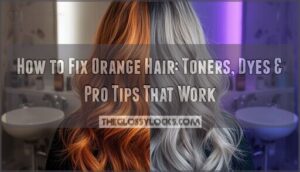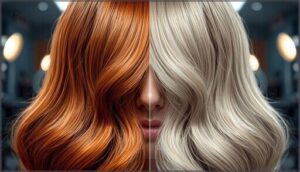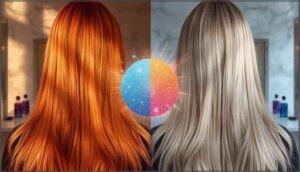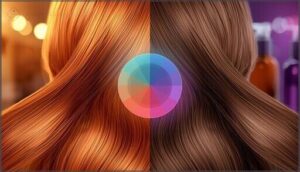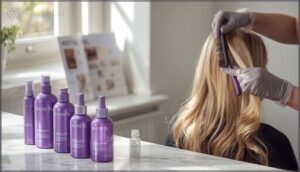This site is supported by our readers. We may earn a commission, at no cost to you, if you purchase through links.
You followed the tutorial perfectly, mixed your bleach with confidence, and then—disaster. Your hair didn’t lift to that cool-toned blonde you were dreaming of. Instead, you’re staring at a pumpkin-orange mess that screams “DIY gone wrong.”
This happens because bleach breaks down the dark eumelanin pigments in your hair first, exposing the stubborn warm pheomelanin underneath.
The good news? Orange hair isn’t permanent, and you don’t need to panic-book an expensive salon appointment just yet. With the right toner, dye selection, or even a strategic blue shampoo routine, you can neutralize those brassy tones and reclaim your hair confidence.
Table Of Contents
- Key Takeaways
- Why Does Hair Turn Orange?
- How to Identify Your Orange Hair Level
- What Toner Neutralizes Orange Hair?
- How to Fix Orange Hair With Toner
- Fixing Orange Hair With Blue or Purple Shampoo
- Dyeing Over Orange Hair: is It Effective?
- How to Lighten Orange Hair Safely
- At-Home Remedies for Orange Hair
- Preventing Orange Hair in The Future
- When to See a Professional Colorist
- Frequently Asked Questions (FAQs)
- Conclusion
Key Takeaways
- Orange hair happens because bleach strips dark eumelanin pigments first, exposing the stubborn warm pheomelanin underneath—it’s not a mistake, just basic color chemistry at work.
- Blue-based toners neutralize orange tones directly by using opposite colors on the color wheel, while purple toners only cancel yellow (so they won’t fix your orange problem).
- You can dye over orange hair successfully if you choose an ash-based color at least one level darker, since those blue-green undertones work to cancel out brassiness.
- Wait at least 2-4 weeks between bleaching sessions and deep condition weekly with bond-building treatments—over-bleaching destroys your hair’s protein structure and causes permanent damage that no product can fully reverse.
Why Does Hair Turn Orange?
Orange hair isn’t a mistake you made—it’s actually part of the science of how hair color works. When you bleach or lighten dark hair, you’re basically peeling back layers of pigment, and orange is one of those stubborn stages that loves to stick around.
Let’s break down exactly why this happens so you can fix it with confidence.
Underlying Pigments in Dark Hair
Your dark hair holds layers of pigments—over 95% is eumelanin, which creates those rich brown to black tones. Buried underneath? Pheomelanin, the reddish-yellow troublemaker that causes orange hair and brassy tones when exposed.
These pigments sit in your hair follicle’s cortex, densely packed. When you lighten, eumelanin breakdown happens first, revealing that stubborn orange undertone—classic melanin distribution at work in color chemistry.
Understanding the melanin production process is essential for addressing hair color issues.
Effects of Bleaching on Hair Color
Bleach damage begins when hydrogen peroxide penetrates your hair cortex, breaking down melanin granules through chemical reactions. That color shift from brown to orange? It’s partial pigment destruction—your hair pauses mid-process at those stubborn warm tones. The oxidation also raises hair porosity, leaving your cuticle rough and exposed.
Brassy hair happens because bleaching removes pigments unevenly, revealing leftover orange undertones. That’s precisely when toner formulas become essential to neutralize what hair lightening leaves behind. Understanding hair breakage causes is vital to addressing the damage and finding the right solutions.
Common Mistakes That Cause Orange Hair
Pulling bleach too early is the number one culprit—over 70% of orange hair disasters happen from cutting timing short. Uneven bleach application creates patchy orange spots, while wrong developer strength just won’t lift those stubborn pigments.
Skipping strand testing? You’re flying blind.
And here’s the kicker: using incorrect toner selection after all that effort can actually make brassy hair worse instead of fixing it.
How to Identify Your Orange Hair Level
Before you can fix orange hair, you need to figure out exactly where you’re starting from. Not all orange is created equal—your hair’s current level determines which toner, dye, or technique will actually work.
Let’s break down how to assess your specific shade of orange so you can choose the right correction method.
Hair Color Levels and Brassiness
Understanding hair color levels is your roadmap to brassiness prevention and effective color correction. Levels range from 1 (black) to 10 (lightest blonde), and those brassy tones you’re seeing? They usually show up between levels 5-8 after bleaching.
Hair pigment science tells us that incomplete lifting leaves warm pigments behind. Identifying your exact level helps you choose the right toner formulation for proper color correction techniques without risking bleach damage repair later.
Assessing Orange Tones After Bleaching
You can’t fix what you don’t see clearly. After bleaching, wait 2-5 days before doing your orange tone analysis—your hair needs time to settle and reveal its true color.
Check those brassy tones under natural light, not your bathroom bulbs. Look at whether the orange is patchy or even across your strands. This visual assessment guides your entire color correction strategy and prevents further bleach damage.
What Toner Neutralizes Orange Hair?
If you’ve been staring at your orange hair wondering what on earth will fix it, the answer is simpler than you think: the right toner.
Not just any toner will work, though—it all comes down to color theory and matching the correct shade to your specific orange situation.
Let’s break down which toners actually neutralize orange and how to pick the one that’ll save your color.
Blue Vs. Purple Toner Explained
Think of toners as your color correction toolkit—you wouldn’t use a hammer to tighten a screw, right? Here’s what you need to know about fixing orange hair:
- Blue toner neutralizes orange tones directly (it’s opposite orange on the color wheel)
- Purple toner cancels out yellow, not orange
- Blue shampoo maintains results for darker, brassy hair
- Purple shampoo works for already-blonde hair fighting yellowness
- Hair pigmentation level determines which toner you’ll need
Choose based on what you see in the mirror.
Choosing The Right Toner for Your Hair
Your orange hair level is your roadmap here. For light brown to medium blonde shades (levels 4-6), grab a blue-based toner—it’s your direct fix.
Hair porosity matters too: porous strands drink up toning product faster, so you might need less processing time. Check toner ingredients for blue pigments, not purple ones.
This color correction approach keeps things balanced and natural-looking.
How to Fix Orange Hair With Toner
Now that you know which toner to use, it’s time to actually apply it. The process isn’t complicated, but there are a few important steps you don’t want to skip if you want even, natural-looking results.
Here’s how to go from brassy orange to the cool-toned shade you’ve been dreaming of.
Preparing Hair for Toning
Before toner can work its magic, your hair needs to be primed like a blank canvas. Skip the guesswork and follow these essential prep steps to avoid patchy results and protect your strands from further damage:
- Clarify thoroughly: Use a clarifying shampoo to strip away product buildup, oils, and residue that block toner absorption
- Check your porosity: Over-processed hair grabs toner too fast, creating uneven, overly dark patches
- Balance moisture levels: Towel-dry to damp—not soaking wet—so toner distributes evenly without dilution
- Shield your scalp: Apply barrier cream or oil along your hairline to prevent irritation from toner chemicals
- Assess your orange level: Identify whether you’re dealing with light or deep orange tones to choose the right toner strength
Step-by-Step Toner Application
Ready to take control of your color correction? Start by sectioning your hair into four quarters, then work the blue-based toner from roots to ends using smooth, deliberate strokes.
Keep one eye on the clock and the other on your strands—hair porosity affects timing, so strand-test every five minutes to catch your perfect tone before over-processing kicks in.
Mixing and Applying Toner Safely
Precision matters when mixing toner—get the ratio wrong, and you’re looking at patchy results or damaged strands.
Mix one part blue-based toner with two parts developer (stick to 10 or 20 volume) in a non-metallic bowl until smooth.
Apply with gloves, watch that clock like a hawk, and rinse the moment you hit your target shade to prevent overprocessing.
Post-Toner Care and Conditioning
Once you’ve rinsed out that toner, your hair’s thirsty—it just survived a chemical marathon. Apply a color-protecting shampoo and conditioner immediately to lock in moisture retention and prevent fading. Your post-toner repair routine makes or breaks your results.
Here’s what your hair desperately needs now:
- Deep conditioning masks weekly to restore strength and hair hydration
- Sulfate-free products that won’t strip your fresh tone
- Leave-in treatments for ongoing hair repair and protection
- Heat styling breaks (at least 48 hours) to prevent further damage
- Regular trims to maintain healthy ends post-treatment
Wait 72 hours before your next full shampoo—this gives the color time to properly set into your cuticle. Think of toner maintenance like skincare: consistency beats intensity every time.
Fixing Orange Hair With Blue or Purple Shampoo
If you don’t want to commit to a full toning session right away, blue and purple shampoos offer a gentler way to neutralize orange tones over time. These color-depositing formulas work gradually with each wash, making them perfect for maintaining your color between salon visits or fixing mild brassiness at home.
Here’s how to choose the right one and use it effectively without overdoing it.
When to Use Blue Vs. Purple Shampoo
Here’s the truth about pigment neutralization: blue shampoo counteracts orange and red brassy tones in brunette hair, while purple shampoo fights yellow in blonde or silver strands.
If your color correction left you with stubborn orange, reach for blue—it’s your weapon for toner application maintenance. Purple won’t cut it on deep orange, but it’ll keep your lightened locks cool between proper hair toning sessions.
Application Tips for Best Results
Start with damp hair—wet strands open your cuticles for better color correction. Massage your toning shampoo from roots to ends, targeting orange-heavy zones with extra product.
Here’s where hair porosity matters: porous hair absorbs pigment faster, so watch your timing. Three to seven minutes gives solid results without overdoing it.
Rinse with cool water to lock in your toner application and keep that neutralizing power working.
How Often to Use Toning Shampoo
Toning frequency depends on your hair porosity and washing routine. Here’s your maintenance rhythm:
- Normal hair: Use blue shampoo twice weekly to keep brassy tones at bay
- Porous or bleached strands: Once per week prevents purple shampoo from overtoning
- Thicker, resistant hair: You can handle toner duration closer to three times weekly
Shampoo alternation with sulfate-free formulas protects your color maintenance between toning sessions.
Dyeing Over Orange Hair: is It Effective?
If you’re staring at orange hair and wondering if you can just dye over it, the short answer is yes—but only if you choose the right shade.
Dyeing over orange requires understanding color theory and selecting tones that’ll neutralize, not intensify, that brassy situation you’ve got going on.
Here’s what you need to know to make it work.
Choosing The Right Shade to Cover Orange
When you’re covering orange hair with dye, you’ll want to choose a shade at least one level darker than your current color—think medium or dark ash brown.
That blue or green undertone in ash-based formulas is your secret weapon for neutralizing orange hair and kicking brassy tones to the curb. The darker depth ensures even coverage while those cool pigments handle the color correction work.
Using Ash-Based Hair Colors
Ash dye formulations pack that blue-green punch you need for serious hair pigment correction. These color neutralization techniques work because ash color theory puts complementary pigments directly where orange lives.
- Ash blue additives mixed at levels 6-7 knock out stubborn yellowish-orange tones
- Ash grey formulas combine green and ash pigments to tackle reddish-orange on darker bases
- Demi-permanent ash colors neutralize brassiness without additional bleaching, lasting 12-24 washes
Professional-grade ash blonde shades deliver both color correction and that coveted cool-toned base.
Step-by-Step Dye Application
To master hair dye application when dyeing over orange hair, section your hair into four clean parts—this makes color correction way more manageable. Apply dye to roots first, then work through mid-lengths and ends for even coverage.
Set a timer to follow the hair color process exactly, then rinse with lukewarm water. This systematic approach prevents patchy toner follow-up disasters.
How to Lighten Orange Hair Safely
Sometimes orange hair just needs a little more lift to reach a cooler, lighter tone. But before you reach for that bleach again, you need to know the right timing, the real risks, and whether you should handle this yourself or call in backup.
Let’s break down how to lighten orange hair without wrecking what you’ve got.
When and How to Re-Bleach Hair
If your orange hair didn’t lift enough, you might be tempted to bleach again right away—but hold on. Your strands need time to recover. Here’s how to approach rebleaching safely:
- Wait at least 2-4 weeks between sessions so your hair can rebuild strength and moisture
- Deep condition weekly with bond-building treatments like Olaplex to prep for the next round
- Apply bleach evenly and monitor closely to avoid patchy lifting during the hair bleaching process
Risks of Over-Bleaching
Bleaching too often literally breaks down your hair’s protein backbone—over 60% of frequent bleachers report serious hair breakage within weeks. You’re risking chemical burns on your scalp, structural weakness that can’t be fully reversed, and even permanent thinning in severe cases.
Over-bleaching destroys your hair’s protein structure, causing breakage, chemical burns, and even permanent thinning in severe cases
Overbleaching during the hair bleaching process transforms orange hair problems into damage that no conditioner can truly fix.
Professional Vs. At-Home Lightening
Professional techniques deliver lighter, healthier results. Salons can lift 9-10 levels with controlled timing and bond-repair products, while at-home kits manage just 2-4 levels and risk chemical burns.
The cost comparison? $150-$400 versus $54-$290, but DIY often needs professional correction anyway.
Safety measures matter: trained colorists prevent the damage control nightmares you’ll face bleaching solo in your bathroom.
At-Home Remedies for Orange Hair
If your hair’s turned orange and you’re not ready to hit the salon, there are a few tricks you can try at home. These options are simple, affordable, and easy to fit into your routine.
Let’s look at what you can use to tackle those brassy tones yourself.
DIY Blue Toning Masks
You can whip up your own blue mask recipes at home using blue pigments and conditioner—about 78% of users see real improvement at lighter levels.
Mix carefully, test a strand first, and apply once a week for color correction without the salon bill.
Just watch out: overuse or high concentrations can cause irritation or staining, so stick to DIY safety tips and keep processing time under 30 minutes.
Apple Cider Vinegar Rinses
Beyond blue masks, apple cider vinegar rinses help reset your hair pH balance—around 3 to 5—which smooths cuticles and boosts shine while removing buildup that worsens brassiness.
Mix one part ACV with four parts water, apply after shampooing, let it sit a few minutes, then rinse.
This natural clarifier won’t neutralize orange tones like a toner, but it preps your scalp health and strands for better color correction results.
Color-Depositing Conditioners
Color-depositing conditioners offer another route to tackle orange tones—they’re gentler than toner and work weekly to refresh your shade.
Product innovation has brought sulfate-free conditioner formulas packed with blue or purple pigments, depending on your hair porosity and color retention needs.
Market trends show millennials love these for at-home maintenance between salon visits, delivering noticeable results after one or two uses without harsh chemicals.
Preventing Orange Hair in The Future
The best fix for orange hair? Not getting it in the first place.
A few smart moves before and after you color can save you from that brassy nightmare altogether. Let’s talk about what actually works to keep your color clean from the start.
Using The Correct Bleach and Developer
The secret to avoiding orange disasters? Nail your bleach ratio and developer choice from the start. Stick to a 1:2 bleach-to-developer ratio for most hair types—that’s one part powder to two parts developer.
Dark hair needs 30-volume developer for effective lifting, while fine hair does better with 20-volume to prevent damage.
Don’t wing it: test a strand first and monitor your processing time carefully.
Proper Hair Care After Coloring
Commitment to your hair’s health maintenance pays off—color protection depends on what you do after leaving the salon. Switch to a color-protecting shampoo immediately; sulfate-free formulas keep 20% more vibrancy over two months.
Deep condition weekly to boost elasticity by 52% and repair damage. Wait 48 hours before washing to lock in 30% more pigment, and skip hot water—it strips color faster than anything.
Protecting Hair From Environmental Factors
Environmental stress wreaks havoc on freshly colored hair—UV rays alone cause 15% faster fading. Protect your investment with leave-in barrier products that block 35% of pollutant damage.
Air pollution and chlorine accelerate chemical damage, so wear hats outdoors and rinse before swimming.
Weekly hair masks rebuild strength against these aggressors, keeping your color locked in longer.
When to See a Professional Colorist
Sometimes orange hair fights back harder than expected, and that’s when it’s time to call in backup. A professional colorist has the tools, experience, and color correction skills to rescue hair that’s been through too much at home.
Let’s look at the signs you need expert help, what happens during a color correction appointment, and how to keep those results looking fresh.
Signs You Need Expert Help
If you’ve tried multiple at-home fixes with zero improvement, it’s time for professional intervention. Persistent patchiness, severe hair breakage, stubborn orange that won’t budge, or scalp irritation signal you need a professional colorist.
About 72% of DIY corrections result in uneven color, and chemical damage only worsens with repeat attempts. A hair color correction process requires expert assessment to avoid permanent harm.
What to Expect From a Color Correction Service
A professional consultation starts with a thorough hair damage assessment to determine the safest color correction process. Your colorist will map out a tailored plan, which might span multiple sessions—about 85% of corrections require more than one visit.
Here’s what the professional hair color correction usually includes:
- Strand and elasticity testing to gauge your hair’s chemical tolerance
- Custom toner selection tips based on your underlying pigment and desired outcome
- Gradual lightening or filling treatments to balance uneven color without over-processing
- Glossing or conditioning services to restore shine and strengthen damaged strands
- Post correction care instructions and product recommendations for long-lasting results
Expect realistic timelines—color correction is gradual, not instant magic.
Maintaining Results After Professional Fix
Your colorist’s work doesn’t end when you leave the chair—protecting hair color takes commitment. Reduced washing to 2-3 times weekly prevents 40% more fade than daily shampooing. Swap to color-safe products and apply sun protection before heading outdoors.
Schedule professional touch-ups every 3-5 weeks to maintain your investment in long-term hair maintenance. This routine keeps brassy tones at bay, ensuring your color stays vibrant.
Frequently Asked Questions (FAQs)
Can orange hair damage be permanently reversed?
Once your hair turns orange, true molecular restoration is a myth—damage to melanin is permanent.
However, bond-building treatments and toners can dramatically improve appearance, offering solid hair repair options without complete color reversal.
Does hair porosity affect orange toning results?
Yes, hair porosity dramatically impacts toner absorption and orange neutralization. Porous hair grabs pigment faster, often causing patchy results.
You’ll need protein treatments or porosity equalizers before applying toner for even color correction.
Will orange hair fade naturally over time?
Unfortunately, it won’t—at least not in the way you’re hoping. Orange tones from bleaching don’t naturally fade since they’re exposed underlying pigments, not deposited color that washes out over time.
Can vitamin C treatments remove orange tones?
Vitamin C treatments can fade orange tones slightly, especially on semi-permanent color, by breaking down surface dye molecules. However, they’re less effective on permanent color and may cause dryness, making professional toners better for color neutralization.
Is orange hair more prone to breakage?
Bleached strands showing orange tones signal chemical stress and structural weakness from incomplete pigment removal.
That porosity damage increases hair breakage risk by up to 20%, making fragile fibers snap under routine styling and environmental factors affecting overall hair health.
Conclusion
Orange hair is like a detour, not a dead end—you’ve got the map now to get back on track. Whether you reach for a blue toner, an ash dye, or a strategic shampoo routine, you’re equipped to fix orange hair without the salon panic.
Trust the process, respect your hair’s limits, and don’t be afraid to call in a pro if things feel out of control. Your dream color is still within reach.
- https://www.instagram.com/p/CKyw939h4o1/
- https://www.freepik.com/free-photo/content-client-salon-having-coloring-procedure_1935362.htm
- https://pmc.ncbi.nlm.nih.gov/articles/PMC9953601/
- https://www.glamot.com/blog/35145/what-is-a-hair-toner
- https://www.madison-reed.com/blog/how-to-tone-orange-hair-effectively

